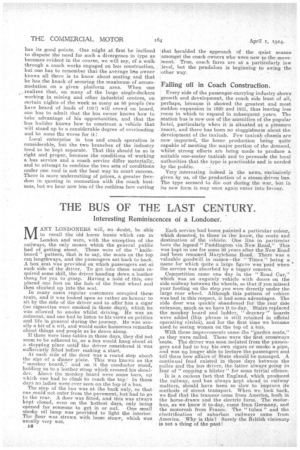THE BUS OF THE LAST CENTURY.
Page 2

If you've noticed an error in this article please click here to report it so we can fix it.
Interesting Reminiscences of a Londoner.
MANY LONDONERS will,. no doubt, be able to recall the old horse buses which ran in London and were, with the exception of the railways, the only means which the general public had of getting about. These were of the " knifeboard " pattern, that is to say, the seats on the top ran lengthways, and the passengers sat back to back. A box seat was provided on which passengers sat at each side of the driver. To get into these seats required some skill, the driver handing down a leather thong for you to grasp. Having a bold of this' one placed one foot on the hub of the front wheel and then climbed up into the seat. In many cases regular customers occupied them seats, and it was looked upon as rather anhonour to sit by the side of the driver and to offer him a cigar (no cigarettes were smoked in those days), which he was allowed to smoke whilst driving. He was an autocrat, and one had to listen to his views on politics and life in general during the journey. He was usually a bit of a wit, and would make humorous remarks about things and people as he drove along.
If there were time-tables in those days, they did not seem to be adhered to, as a bus would hang about at a stopping place until' the driver considered it. was aufficiently filled before making a start.
At each side of the door was a round step about the size of a dinner plate. This was known as the "monkey board,"_ and on it the conductor stood, holding on to a leather strap which crossed his shoulder. Above the monkey board were some bars, up which one had to climb to reach the top. In those days no ladies were ever seen on the top of a bus.
The step of the bus was at the back only, so that one could not enter from the pavement, but hadto go to. the rear. A door was fitted, and this was always kept closed, even on the hottest days, only being opened for someone to get in or out. One small smoky oil lamp was provided to light the interior. The floor was strewn with loose straw, which was usually very wet.
Each service had buses painted a particular colour, which denoted, to those in the know, the route and destination of the vithicle. One line in particular bore the legend" Paddington via New Road," This was kept in use for some 30 years after the New Road nad been renamed Marylebone Road. There was a valuable goodwill in names—the " Times" being a name for which quite a large figure was 'paid when the service was absorbed by a bigger concern.
Competition came one day in the "Road Car," which was an ungainly vehicle with doors on the Side midway between the wheels, so that if you missed your footing on the step you were directly under the large rear wheel. • Although this pattern of vehicle was bad in this respect, it had some advantages. The side door was quickly abandoned for the rear side entrance, much as we have it to-day. Stairs replaced the monkey board and ladder, " decency " boards were added (this phrase is still retained in official operating circles), and for the first time we became used to seeing women on the top of a bus.
With these improvements came the "garden seats," as they were 'called. These were the first crossways seats. The driver was soon isolated from the passengers and had to buy his own cigars or smoke a pipe, and was no longer able to lecture the passengers and tell them how affairs of State should be managed. A Continual feud existed in those days between the police and the bus driver, the latter always going in fear of " copping a blister " for some trivial offence.
It is a curious fact that England, which produced the railway, and has always kept ahead in railway matters, should have been so slow to improve its methods of street transport. When we look back, we find that the tramcar came from America, both. in the horse-drawn and the electric form. The motorbus, as we know it to-day, came from Germany, and the motorcab from France. The " tubes " and the electrification of suburban railways came from America. Why is this ? Surely the British visionary is not a thing of the past!






















































